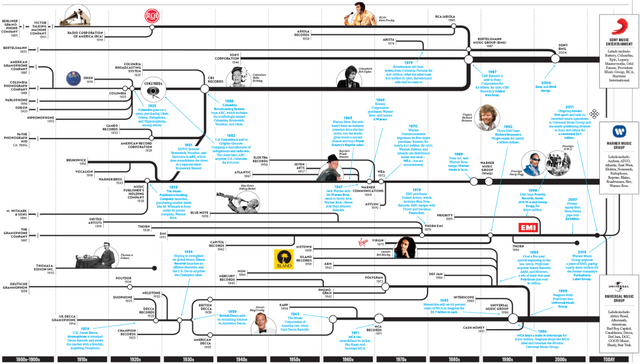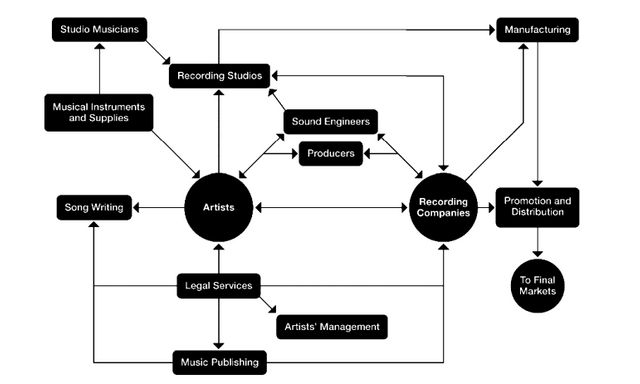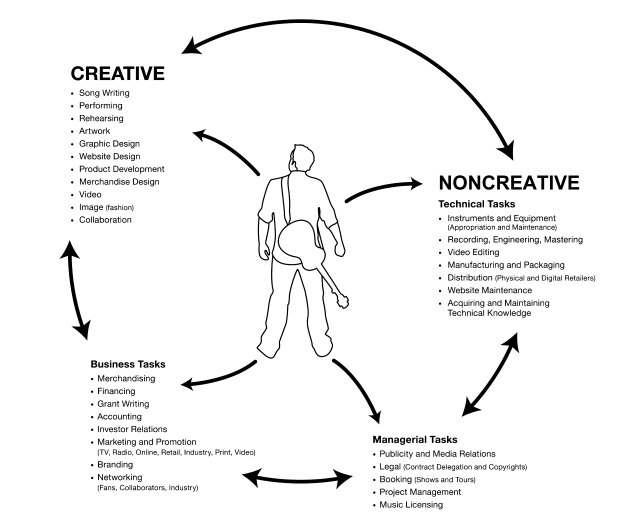How Traditional Forecasting Failed the Music Industry
There are many examples of organizations and industries that have used traditional forecasting models in situations where scenario planning would have been a more appropriate approach to disaster preparation. The music industry is one of the most glaring examples of this situation, in that the entire industry was caught off guard by the advent of peer-to-peer file sharing. As the industry faced the looming threat of loss of profits due to piracy, many executives resisted the technological change and attempted to use litigation to prevent p2p services from impacting their revenues (Hracs, 2012). As the music industry had dramatically changed over time, the landscape went from dozens of major record labels in the ‘50s down to five major labels in 1999 (Hracs, 2012). A merger in 2004 between Sony and BMG saw the industry technically shrink to four major labels, and finally in 2012 down to three majors (Hracs, 2012).

While the industry evolved, investment into individuals became more refined as the risks associated with building an artist grew. Major labels resorted to investing in smaller labels, which were tasked with finding the talent, marketing the music, and building a community around the artist (Hracs, 2012). In its nascent stages the music industry had enjoyed a mutually beneficial relationship with the technology industry. The growth that the industry had experienced up to its peak in 1997 created a culture that made executives believe the models they had used to forecast their strategies were so successful that they would not need any modification (Hracs, 2012). In 1999, the introduction of the file sharing service “Napster” would prove that the music industry would soon be facing what is now referred to as the “MP3 Crisis”. (Hracs, 2012).

The MP3 Crisis resulted in the industry scrambling to understand new methods of monetization in the face of an increasingly connected World Wide Web making file sharing easier than going through traditional distribution channels. One of the more counter-intuitive strategies that came from this exploration of new approaches was for companies to relax the digital rights management associated with intellectual properties (Zhang, 2016). While it was not consistent in every situation, labels that relaxed their DRM had sales rates roughly 10% higher than labels that enforced strict DRM policies (Zhang, 2016). Additionally, as traditional label models become outdated the metrics for success in the music industry are shifting within the culture. The ubiquity of free music streaming services have made it so that the measure of success has more to do with the capacity for musicians to garner attention on social media as it is very difficult to generate sales on the same scale in 2020 as it was in the early days of the music industry (Greener et al., 2019).

This shifting landscape is resulting in musicians often functioning as their own management and public relations team until they become well-known enough to establish an independent label or have their brand licensed or purchased by a major label. In these cases, the major labels have fewer advantages to offer the independent artists. This results in the major labels shifting their artist support to social media outreach, community building, as well as non-musical content production in the form of Instagram posts, Tik-Toks, or promotional videos on Youtube (Greener et al., 2019). In this context, what is being called “electronic Word of Mouth” has a direct influence on the resulting sales of a given piece of media (Greener et al., 2019). Using these concepts, examining the eWoM volume surrounding an artist or piece of media shows correlation to the success of the given media (Greener et al., 2019).
As technology evolves to meet the needs of increasingly nuanced demographics, solutions to the problem of DRM specifically in the context of music have emerged that utilize the best aspects of social media, blockchain technology, and pseudonymized data-tracking. Sony is piloting a project that combines blockchain technology, AWS, and identity management to properly compensate musicians who have distributed their songs within this system (Certain, 2019).
This process recognizes the evolving nature of content sharing which necessitates following Copyright laws while attempting to compete with the prospect of a free, albeit illegal alternative (Certain, 2019). As this system reduces the cost for the consumer and maximizes the profit for the content producer, this streamlined distribution flow becomes the most viable path for major labels to offer services to musicians.
In this light, as independent alternatives to the major label channels emerge, platforms like Fanmix will ultimately challenge the concept of major label dominance and scenario planning becomes much more useful for planning a strategy for the music industry. As platforms like Fanmix can offer DRM, identity management, as well as facilitate royalty payments to the artist, the capacity for major labels to retain control over distribution channels will eventually depend solely upon the quality of the content they are distributing as their technological advantages over independent labels will have been completely eroded (Weiner, 2019). As well, the movement of society away from centralized authorities will make decentralized platforms like Fanmix more in line with the shifting culture than major labels (Weiner, 2019).
References:
Certain, A. (2019, November 19). How Sony Is Protecting Rights Of Digital Creators Using Blockchain on AWS. Retrieved from https://www.forbes.com/sites/amazonwebservices/2019/11/19/how-sony-is-protecting-rights-of-digital-creators-using-blockchain-on-aws/#3d00fc703d2c.
Greener, G., Salcum, S., & Goldberg, D. (2019). Electronic Word of Mouth and the Music Industry in the Age of Web 2.0.
Hracs, B. J. (2012). A creative industry in transition: the rise of digitally driven independent music production. Growth and Change, 43(3), 442-461.
Negus, K. (2019). From creator to data: the post-record music industry and the digital conglomerates. Media, Culture & Society, 41(3), 367-384.
Weiner, B. (2019, November 14). What is Fanmix? Retrieved from https://medium.com/fanmix/what-is-fanmix-943223b1d734.
Zhang, L. (2016). Intellectual property strategy and the long tail: Evidence from the recorded music industry. Management Science, 64(1), 24-42.
Medium Link: https://medium.com/swlh/how-traditional-forecasting-failed-the-music-industry-97530def6f86
May I suggest you include the link to Medium in your post next time?
i posted it here first, and then reposted to medium, but that is a good suggestion!
https://medium.com/swlh/how-traditional-forecasting-failed-the-music-industry-97530def6f86
This post was shared in the Curation Collective Discord community for curators, and upvoted and resteemed by the @c-squared community account after manual review.
@c-squared runs a community witness. Please consider using one of your witness votes on us here
Congratulations @chris-bates! You have completed the following achievement on the Steem blockchain and have been rewarded with new badge(s) :
You can view your badges on your Steem Board and compare to others on the Steem Ranking
If you no longer want to receive notifications, reply to this comment with the word
STOPVote for @Steemitboard as a witness to get one more award and increased upvotes!